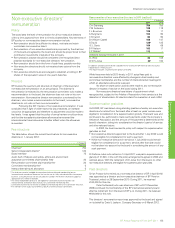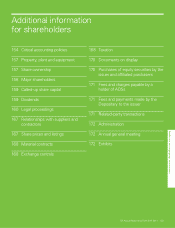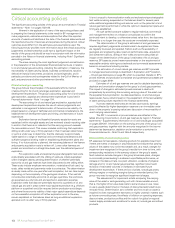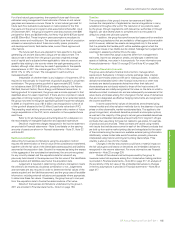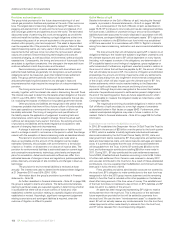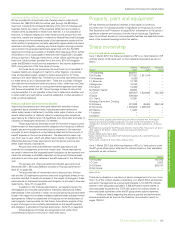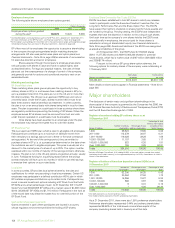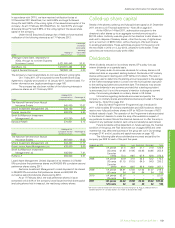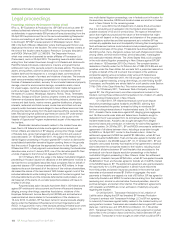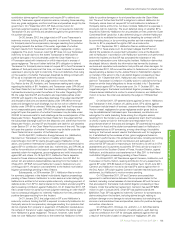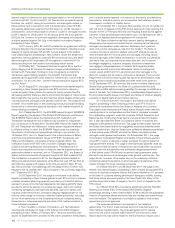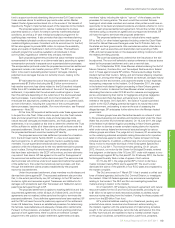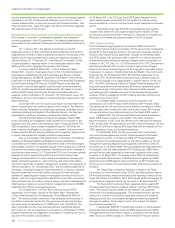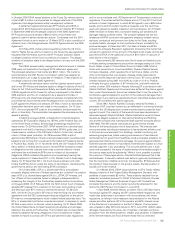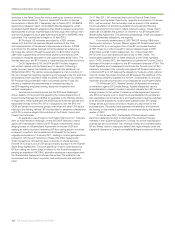BP 2011 Annual Report Download - page 163
Download and view the complete annual report
Please find page 163 of the 2011 BP annual report below. You can navigate through the pages in the report by either clicking on the pages listed below, or by using the keyword search tool below to find specific information within the annual report.
Additional information for shareholders
BP Annual Report and Form 20-F 2011 161
Additional information for shareholders
contribution claims against Transocean and require BP to defend and
indemnify Transocean against all pollution claims, including those resulting
from any gross negligence, and from civil fines and penalties sought by the
government. On 7 December 2011, BP filed a cross-motion for
summary judgment seeking an order that BP is not required to indemnify
Transocean for any civil fines and penalties sought by the government or
for punitive damages.
On 26 January 2012, the judge ruled on BP’s and Transocean’s
indemnity motions, holding that BP is required to indemnify Transocean
for third-party claims for compensatory damages resulting from pollution
originating beneath the surface of the water, regardless of whether
the claim results from Transocean’s strict liability, negligence, or gross
negligence. The court, however, ruled that BP does not owe Transocean
indemnity for such claims to the extent Transocean is held liable for
punitive damages or for civil penalties under the Clean Water Act, or
if Transocean acted with intentional or wilful misconduct in excess of
gross negligence. The court further held that BP’s obligation to defend
Transocean for third-party claims does not require BP to fund Transocean’s
defence of third-party claims at this time, nor does it include Transocean’s
expenses in proving its right to indemnity. The court deferred a final ruling
on the question of whether Transocean breached its drilling contract with
BP so as to invalidate the contract’s indemnity clause.
On 22 February 2012, the judge ruled on motions filed in the
DoJ Action by the US, Anadarko, and Transocean seeking early rulings
regarding the liability of BP, Anadarko, and Transocean under OPA 90 and
the Clean Water Act, but limited the order to addressing the discharge of
hydrocarbons occurring under the surface of the water. Regarding OPA
90, the judge held that BP and Anadarko are responsible parties under
OPA 90 with regard to the subsurface discharge. The judge ruled that BP
and Anadarko have joint and several liability under OPA 90 for removal
costs and damages for such discharge, but did not rule on whether such
liability under OPA 90 is unlimited. While the judge held that Transocean
is not a responsible party under OPA 90 for subsurface discharge, the
judge left open the question of whether Transocean may be liable under
OPA 90 for removal costs for such discharge as the owner/operator of the
Deepwater Horizon. Regarding the Clean Water Act, the judge held that
the subsurface discharge was from the Macondo well, rather than from the
Deepwater Horizon, and that BP and Anadarko are liable for civil penalties
under Section 311 of the Clean Water Act as owners of the well. The judge
left open the question of whether Transocean may be liable under the
Clean Water Act as an operator of the Macondo well.
On 20 April 2011, Halliburton Energy Services, Inc. (Halliburton),
filed claims in Transocean’s Limitation of Liability action seeking
indemnification from BP for claims brought against Halliburton in that
action, and Cameron International Corporation (Cameron) asserted claims
against BP for contribution under state law, maritime law, and OPA 90, as
well as for contribution on the basis of comparative fault. Halliburton also
asserted a claim for negligence, gross negligence and wilful misconduct
against BP and others. On 19 April 2011, Halliburton filed a separate
lawsuit in Texas state court seeking indemnification from BP E&P for
certain tort and pollution-related liabilities resulting from the Incident. On
3 May 2011, BP E&P removed Halliburton’s case to federal court, and
on 9 August 2011, the action was transferred to the federal multi-district
litigation proceedings pending in New Orleans.
Subsequently, on 30 November 2011, Halliburton filed a motion
for summary judgment in the federal multi-district litigation proceedings
pending in New Orleans. Halliburton’s motion seeks an order stating that
Halliburton is entitled to full and complete indemnity, including payment of
defence costs, from BP for claims related to the Incident and denying BP’s
claims seeking contribution against Halliburton. On 21 December 2011, BP
filed a cross-motion for partial summary judgment seeking an order that BP
has no contractual obligation to indemnify Halliburton for fines, penalties, or
punitive damages resulting from the Incident.
On 31 January 2012, the judge ruled on BP’s and Halliburton’s
indemnity motions, holding that BP is required to indemnify Halliburton for
third-party claims for compensatory damages resulting from pollution that
did not originate from property or equipment of Halliburton located above
the surface of the land or water, regardless of whether the claims result
from Halliburton’s gross negligence. The court, however, ruled that BP
does not owe Halliburton indemnity to the extent that Halliburton is held
liable for punitive damages or for civil penalties under the Clean Water
Act. The court further held that BP’s obligation to defend Halliburton for
third-party claims does not require BP to fund Halliburton’s defence of
third-party claims at this time, nor does it include Halliburton’s expenses in
proving its right to indemnity. The court deferred ruling on whether BP is
required to indemnify Halliburton for any penalties or fines under the Outer
Continental Shelf Lands Act. It also deferred ruling on whether Halliburton
acted so as to invalidate the indemnity by breaching its contract with BP,
by committing fraud, or by committing another act that materially increased
the risk to BP or prejudiced the rights of BP as an indemnitor.
On 1 September 2011, Halliburton filed an additional lawsuit
against BP in Texas state court. Its complaint alleges that BP did not
identify the existence of a purported hydrocarbon zone at the Macondo
well to Halliburton in connection with Halliburton’s cement work performed
before the Incident and that BP has concealed the existence of this
purported hydrocarbon zone following the Incident. Halliburton claims that
the alleged failure to identify this information has harmed its business
ventures and reputation and resulted in lost profits and other damages. On
16 September 2011, BP removed the action to federal court, where it was
stayed pending a decision by the Judicial Panel on Multidistrict Litigation
on transfer of the action to the multi-district litigation proceeding in New
Orleans. On 1 September 2011, Halliburton also moved to amend its
claims in Transocean’s Limitation of Liability action to add claims for fraud
based on similar factual allegations to those included in its 1 September
2011 lawsuit against BP in Texas state court. On 11 October 2011, the
magistrate judge in the federal multi-district litigation proceeding in New
Orleans denied Halliburton’s motion to amend its claims, and Halliburton’s
motion to review the order was denied by the judge on 19 December
2011.
On 20 April 2011, BP asserted claims against Cameron, Halliburton,
and Transocean in the Limitation of Liability action. BP’s claims against
Transocean include breach of contract, unseaworthiness of the Deepwater
Horizon vessel, negligence (or gross negligence and/or gross fault as
may be established at trial based upon the evidence), contribution and
subrogation for costs (including those arising from litigation claims)
resulting from the Incident, as well as a declaratory claim that Transocean
is wholly or partly at fault for the Incident and responsible for its
proportionate share of the costs and damages. BP asserted claims against
Halliburton for fraud and fraudulent concealment based on Halliburton’s
misrepresentations to BP concerning, among other things, the stability
testing on the foamed cement used at the Macondo well; for negligence
(or, if established by the evidence at trial, gross negligence) based on
Halliburton’s performance of its professional services, including cementing
and mud logging services; and for contribution and subrogation for
amounts that BP has paid in responding to the Incident, as well as in OPA
assessments and in payments to plaintiffs. BP filed a similar complaint in
federal court in the Southern District of Texas, Houston Division, against
Halliburton, and the action was transferred on 4 May 2011 to the federal
multi-district litigation proceeding pending in New Orleans.
On 20 April 2011, BP filed claims against Cameron, Halliburton, and
Transocean in the DoJ Action, seeking contribution for any assessments
against BP under OPA 90 based on those entities’ fault. On 20 June 2011,
Cameron and Halliburton moved to dismiss BP’s claims against them in
the DoJ Action. BP’s claim against Cameron has been resolved pursuant to
settlement, but Halliburton’s motion remains pending.
On 16 December 2011, BP and Cameron announced their
agreement to settle all claims between the companies related to the
Incident, including mutual releases of claims between BP and Cameron
that are subject to the federal multi-district litigation proceeding in New
Orleans. Under the settlement agreement, Cameron has paid BP $250
million in cash in January 2012, which BP has applied towards the
$20-billion Trust. BP has agreed to indemnify Cameron for compensatory
claims arising from the Incident, including claims brought relating to
pollution damage or any damage to natural resources, but excluding civil,
criminal or administrative fines and penalties, claims for punitive damages,
and certain other claims.
On 20 May 2011, Dril-Quip, Inc. and M-I L.L.C. (M-I) filed claims
against BP in Transocean’s Limitation of Liability action, each claiming
a right to contribution from BP for damages assessed against them as
a result of the Incident, based on allegations of negligence. M-I also


